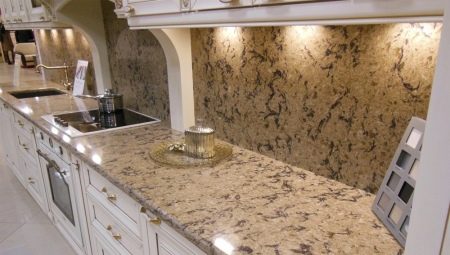The question of what should be the countertop of the kitchen set is especially relevant for those whose kitchen is under repair or those who have decided to replace the old set. Many prefer artificial stone options. However, before buying products from such material it will be useful to get acquainted with their features, various types of raw materials used for their manufacture, as well as the rules for caring for such countertops. All these and other nuances will be discussed in detail in this article.
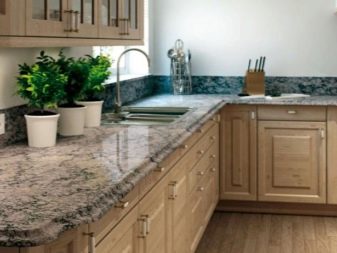
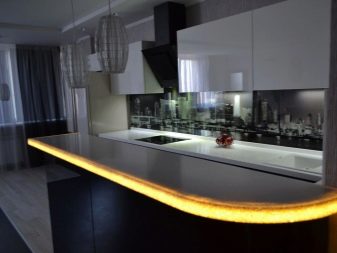
Features
Kitchen worktops made of artificial stone consist of a material that includes stone chips and synthetic resins. This raw material has been manufactured since 1967 and is currently represented by many different companies in the furniture market.
Artificial stone differs from other materials in that its surface is completely devoid of porous formations.
In addition to kitchen worktops, window sills are also made from this raw material, so that you can achieve additional harmony in the interior of the kitchen.
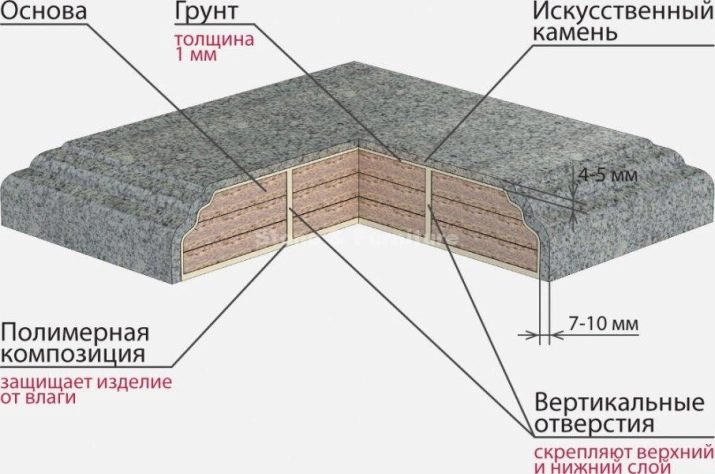
Advantages and disadvantages
The working kitchen surface made of artificial stone has a number of positive qualities, which definitely force many buyers to opt for it.
- Antibacterial properties that are due precisely to the absence of pores on the surface of the material.Particles of food, liquid and other substances do not penetrate the structure of the countertop, leaving it clean and preventing the appearance and reproduction of unwanted microorganisms.
- This property also explains another positive feature of such products - the ease with which they can be cleaned. Dirt, which is not fixed in the pores, can be removed even without the help of chemical cleaners.
- If cuts or cracks may occur on countertops made of other raw materials during operation, then they certainly will not appear on an artificial stone product even after a long time. Raw materials of this type are not susceptible to the effects of blades, therefore, in this way it is quite difficult to damage. But it is worth remembering that the material may not withstand strong shocks.
- The surface of such raw materials can easily withstand high temperatures. Also, mold and fungus patches do not form on it.
- The design of a kitchen worktop made of artificial stone is often unique. You can make the surface look truly spectacular and unusual, since the options for possible colors offered by companies are very diverse.
- Even if the surface of the headset is exposed to ultraviolet rays, the appearance of the artificial stone from this will not deteriorate at all.
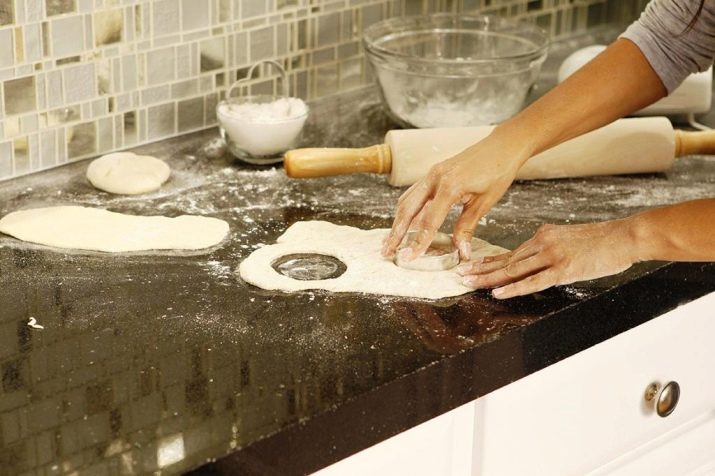
As for the disadvantages of countertops of this type, it is worth noting the following nuances.
- The cost of such a part of the kitchen set will be rather big. The minimum price of one running meter of this product is 7,000 rubles, but many products are even more expensive.
- If there is a need to adjust the shape of the countertops, then it is quite difficult to change the artificial stone yourself. Even if you can cut off the unwanted part with the help of tools, it is hardly possible to achieve perfect evenness and level of polishing.
As can be seen from these lists, the advantages significantly outperform the disadvantages.
In most cases, the need to adjust the shape of the product does not arise. As for the price, it is quite justified by the fact that countertops made of artificial stone can last for many years, while maintaining their presentable appearance.
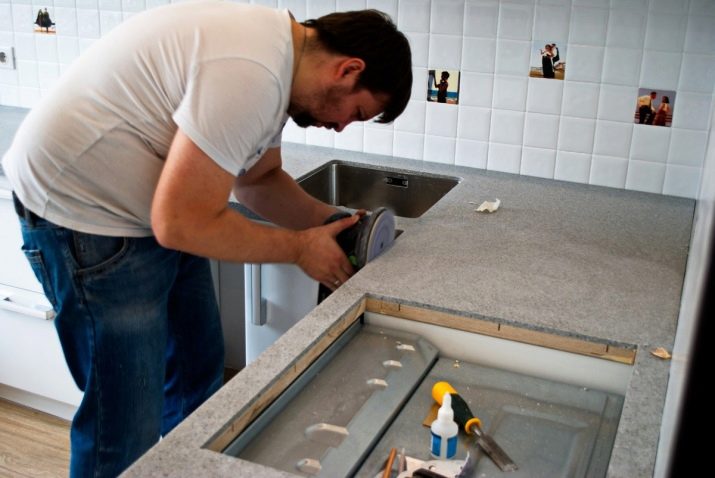
Types and sizes
Kitchen worktops made of artificial stone are classified into a number of varieties. One of the criteria is the thickness of the product. It varies in the following ranges.
- From 3 to 12 mm - an indicator characteristic of products created on the basis of acrylic stone. As the frame here, a special substrate of chipboard, plywood or MDF is used, on which the facing part is attached.
- Thickness indices from 10 to 20 mm can be inherent in composite-type plates, the structure of which does not include a substrate. Sometimes, for a visual thickening of such a countertop, a side can be glued.
- The three-centimeter model no longer requires additional thickening attributes. It may not vary greatly in cost, but there will be much more west of such a design.
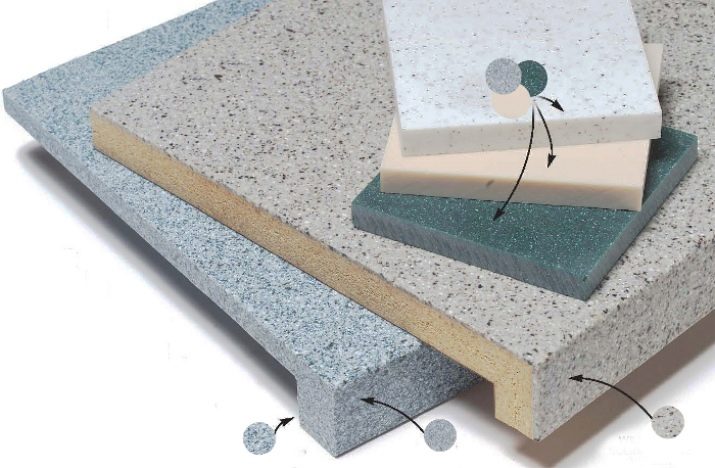
Another criterion for dividing into varieties is the shape of the end of countertops made of natural stone:
- the direct version without bevels is the simplest and is custom-made;
- straight end type 2 + 2 combines simplicity and elegance;
- there are also models with a rounded end;
- the traditional option for the quartz variety of artificial stone is the butt called "pigeon breast";
- if the upper edge of the countertop is wider than the lower and protrudes above it, forming a beveled corner of the end, then this option is called "duck nose";
- soft lines are characteristic of the semicircular end of the product.
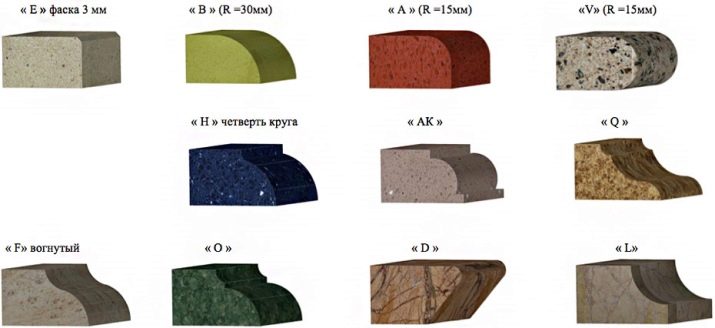
It is also worth paying attention to the shape of the countertops. This parameter can be used to cover with a layer of this material not only headsets, but also other parts of the kitchen. The main forms are as follows.
- Rectangular products - a traditional option, which is often used specifically for headsets with sinks and other attributes. It is noteworthy that if the length of the coating is 3 m, and the selected material is acrylic, then your kitchen will use a solid stove without any seams.
- Sometimes a kitchen set goes into a bar counter and it is for such cases that tabletops made of artificial stone with an arched silhouette are in demand. This option looks strictly, but at the same time very restrained and elegant.
- If in the kitchen there are tables of an angular type, then they will come in handy for the square table top.
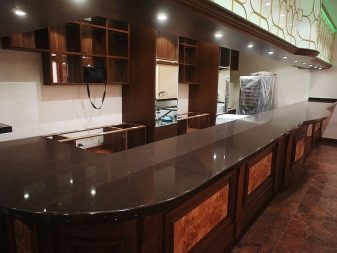


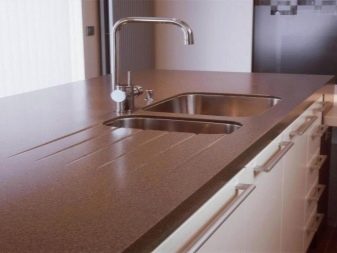
Materials
The following materials are used as the main raw material for countertops of this type.
Quartz Agglomerate
A popular composite is quartz agglomerate, which is more than 90% composed of quartz chips, as well as polyester resin, decorative additives and dyes. The positive sides of countertops made of such material include:
- high strength, which most often explains the long life of the products;
- even the action of aggressive liquids will not damage the material, and as for temperature, contact with hot objects is quite acceptable for a short time;
- the surface is very easy to clean;
- can be embodied in a variety of designs and textures, including matte or textured;
- has a high level of environmental friendliness.
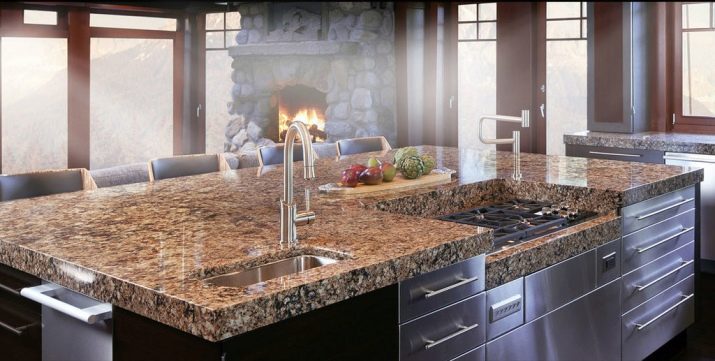
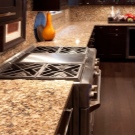


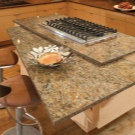

Disadvantages of agglomerate countertops:
- the duration of the set for your kitchen;
- the high cost of products, as well as installation, which is a difficult process;
- the impossibility of installing monolithic plates, especially for large headsets, because of which the countertops are laid with seams;
- material can be embodied only in products of simple geometry.
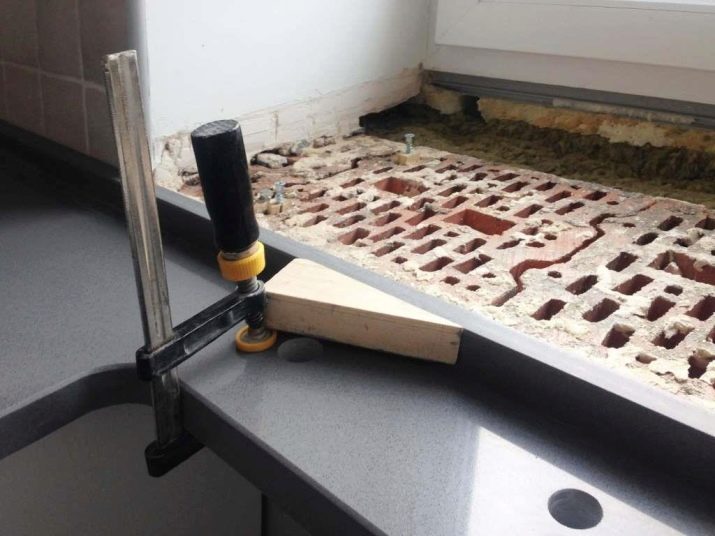
Acrylic
The composition of acrylic stone includes components such as acrylic resin, stone chips, as well as various pigments. Among the advantages of using this material as a tabletop, the following features can be noted:
- uniformity of texture, implying not only the absence of even micropores, but also the integrity of the entire product;
- most relevant for creating products of unusual shape;
- countertops can be embodied in a huge number of color options;
- unlike natural stone, such a material acquires room temperature, therefore it is very pleasant to the touch;
- acrylic can be polished independently, with the help of which it is easy to repair defects with your own hands;
Such countertops are non-toxic and environmentally friendly.


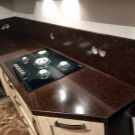
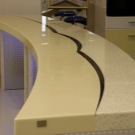
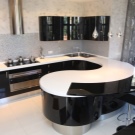
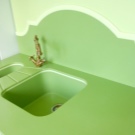
However, one should not ignore some negative characteristics of the material:
- the main one is its susceptibility to scratches and cuts;
- if strong dye is spilled on the surface, there is a risk that the countertop will absorb it;
- they are less resistant to aggressive substances, for example, acids, if acidic liquids get on such a surface, immediately wipe it;
- Also, do not take risks and let the countertop come into contact with hot objects and too hot dishes.

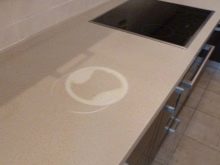
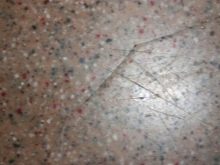
Color spectrum
The palette of colors in which an artificial stone countertop can be framed is quite diverse. The main options include the following:
- imitation of a natural stone surface;
- monophonic option, representing a variety of bright, dark or light tones;
- abstract coloring containing an ornament that does not imitate a stone surface.
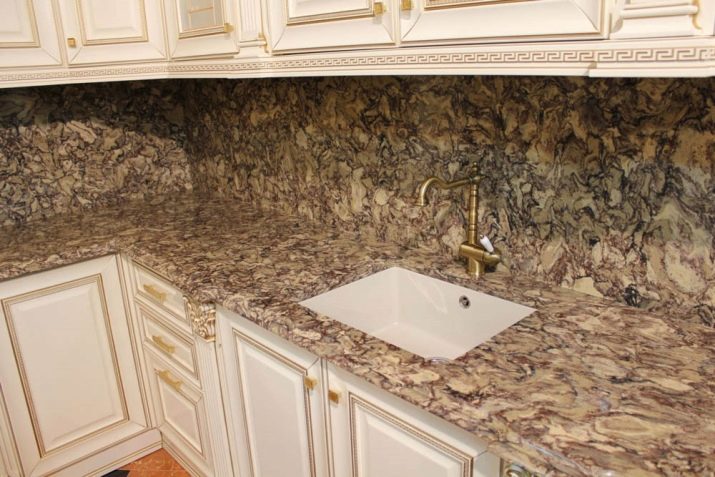
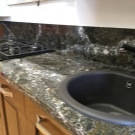
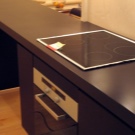
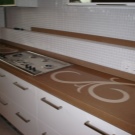
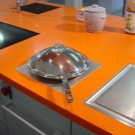

How to choose?
Since the purchase of a cover for a table or a headset in the kitchen requires both financial and time costs, you should be responsible for choosing this product.
- If you are considering options with the possibility of repeated polishing in case of defects, choose countertops with a larger thickness.
- Be sure to ensure that the design of the kitchen cover is consistent with the concept of the interior of the room. You can also find stylish options of a universal type, the color and texture of which will look appropriate in most design concepts.
- If you want to buy a dark or plain coating for a table made of artificial stone, then note that if scratches appear on it, they will be more noticeable than on a surface with an ornament or a lighter color.
- Consider the price range when choosing. It is better to think over the budget in advance based on the surface area of the coating, additional installation costs, the cost of the selected artificial material. For acrylic models, the price range for 1 m2 varies from $ 100 to $ 320, while the minimum price for quartz analogues is $ 150, and the maximum is $ 500.
- Choose products by reading reviews about manufacturing companies in advance.
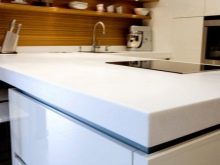
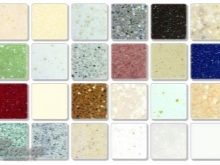

Operation and maintenance
In order for the selected countertop to serve as long as possible and to undergo mechanical damage as little as possible, a number of conditions for its care and maintenance should be observed.
- Minimize contact between hot dishes and the surface.
- Also refrain from using detergents with an aggressive compound or abrasive particles.
- It is imperative that you use a cutting board when grinding products to reduce the likelihood of knife blades coming into contact with artificial stone.
- Even washing sponges are best used with the soft side, otherwise the product will often need polishing.
- If a mineral deposit has formed, it can be removed without aggressive liquids. Normal whiteness or bleach will come in handy. Apply them to the surface for a quarter of an hour, and then remove along with any residue.
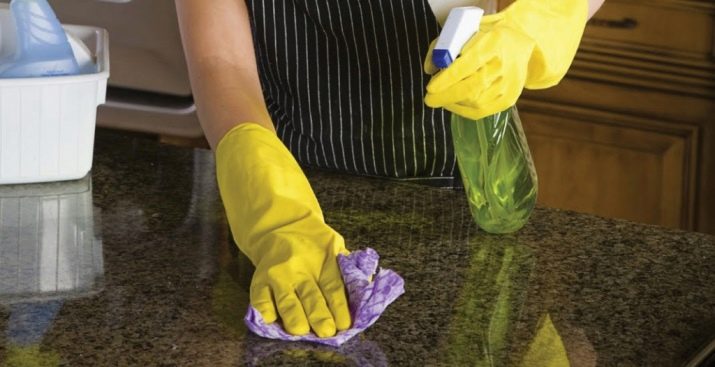
Pros and cons of artificial stone kitchen worktops, see the next video.
